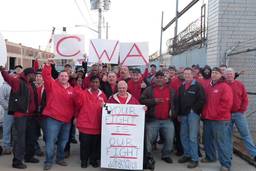According to a report released last week by the Center for Effective Government (CEG), the Occupational Safety and Health Administration (OSHA) inspects only 1 percent of workplaces in the United States in a given year. In the absence of inspections, that means more of the burden to report safety abuses falls on individual workers themselves. However, the CEG study shows that due to weak protection laws, many workers find themselves choosing between reporting a safety violation and keeping their jobs — creating a vicious cycle that can lead to workers too fearful to report potentially deadly workplace hazards.
“Too often, when workers raise concerns about health and safety hazards on the job, employers retaliate with reduced hours or dismissal, even though doing so is clearly illegal,” says Katie Weatherford, regulatory policy analyst at CEG and the author of the report. “Neither federal OSHA, nor its state-level counterparts, currently do enough to protect workers from being harassed, suspended, or fired for reporting health and safety problems, leaving workers with no place to turn.”
A big part of the problem is the law, say advocates. “The protections allotted to workers under 11© of the OSH Act [of 1970] are grossly inadequate and not conducive to building a safe workplace,” says Public Citizen’s Workplace Safety and Health Advocate Keith Wrightson. “As it stands today, 11© is in dire need of modernizing and its directive should provide workers with the strongest language possible.”
Workplace safety and health advocates cite several problems with the current regulations. First, the statute of limitation on when workers can file a complaint for retaliation is too short, they say. Because workers only have 30 days to file a claim under 11©, the section of the Occupational Safety and Health (OSH) Act that concerns retaliatory measures, workers unfamiliar with the law or uncertain of how to proceed may miss the window.
Furthermore, 11© states that OSHA will investigate all claims of retaliation within 90 days of their filing. According to the study, however, it takes OSHA an average length of 150 days to complete an investigation. That’s in part due to OSHA’s limited funding — the agency employs only 96 whistleblower retaliation investigators to look into more than 1,500 annual complaints.
CEG also says that the burden of proof needed to win legal action against an employer is currently too high. Under the OSH Act, a worker must show that their safety complaint was a “motivating factor” in their firing.
The result is that in the end, a tiny fraction of retaliation complaints make their way to court. According to the report, “Between 2005 and 2012, OSHA received 11,153 complaints of retaliation. While 10,380 were reviewed, only 2,542 were found to ‘have merit’” — in other words, OSHA only felt that a quarter of the workers could prove that their employers specifically retaliated against them for sticking up for their safety or for coworkers’. “Of these,” the report continues, “2,390 were settled out of court; 152 were recommended for litigation.”
Previous reports have found that OSHA files suit in only 7 percent of cases recommended for litigation. And because workers lack the right to privately sue on their own if OSHA fails to take up the case in civil court, many workers are left stranded without legal recourse when they’re fired from their jobs.
“OSHA, prioritizing its cases, [passes] on what they think are the best allocations of resources,” says Weatherford, arguing that OSHA, with its limited funds, tends to focus only on trying to litigate the most clear-cut cases of retaliation — the ones they think they’re likely to win. They also avoid “,” Weatherford says, instead prioritizing cases that are likely to set a precedent.
And even if OSHA does find that a case has merit, the OSH Act cannot preliminarily reinstate workers to allow them to support themselves and their families. Meanwhile, a case may take years to complete.
When reached for comment, OSHA said that it was reviewing CEG’s report. “OSHA takes whistleblower protections very seriously, and [has] made major changes in the program in the last several years to increase its effectiveness, and will continue to improve the program. [The] ability of workers to speak out and exercise their legal rights without fear of retaliation is a crucial part of the legal protections and safeguards that all Americans value,” wrote OSHA spokesperson Jesse Lawder in an email to Working In These Times. “Over the last four years, OSHA has implemented new measures to strengthen enforcement — including adding more staff, increasing training of investigators, elevating the Office of Whistleblower Protection Programs and creating the Whistleblower Protection Advisory Committee. WPAC has a working group specifically dedicated to 11©.”
Though there have also been efforts to improve the retaliation protection laws on a federal level, such as the Protecting America’s Workers Act put forth this year by Sen. Tom Harkin (D-Iowa) and Rep. George Miller (D-Calif.), Weatherford says that they have been continuously stalled in Congress. In the meantime, she says, the government should work to protect employees on a state-by-state basis.
Under Connecticut state law, for instance, if OSHA dismisses a worker’s complaint of retaliation, he or she can privately sue the employer for the chance to receive back wages and reimbursement of court and attorney fees. Six other states — Delaware, Montana, New Jersey, Pennsylvania, Colorado and Massachusetts — have varying degrees of whistleblower protection measures that go above and beyond federal law.
“We think until Congress acts,” Weatherford maintains, “that the states should move forward to offer legislation to better protect workers.”
Stronger protection laws like these, advocates say, won’t just help workers within that state — they’ll also increase OSHA’s effectiveness overall.
“Adding these protections to state law will reduce the fear of retaliation and encourage workers to come forward to report health and safety hazards,” said Ronald White, director of regulatory policy of the Center for Effective Government. “Increased reports of workplace hazards will help federal OSHA and state programs identify and target their limited resources to the most dangerous facilities.”









